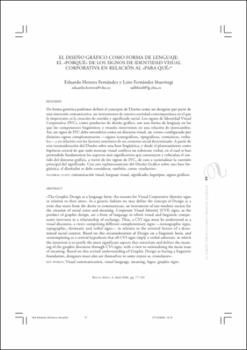El diseño gráfico como forma de lenguaje: el "porqué" de los signos de Identidad Visual Corporativa en relación al "para qué"
Date
2006Abstract
De forma genérica podemos definir el concepto de Diseño como un designio que parte de una intención comunicativa, un instrumento de nuestra sociedad contemporánea en el que lo importante es la creación de sentido y significado social. Los signos de Identidad Visual Corporativa (IVC), como productos de diseño gráfico, son una forma de lenguaje en los que los componentes lingüísticos y visuales intervienen en una relación de intercambio.
Así, un signo de IVC debe entenderse como un discurso visual, un «texto» configurado por distintos signos complementarios —signos iconográficos, tipográficos, cromáticos, verbales— y en relación con los factores exteriores de un contexto social determinado. A partir de esta reconsideración del Diseño sobre una base lingüística, y desde el planteamiento como hipótesis central de que todo mensaje visual conlleva un substrato verbal, en el cual se han pretendido fundamentar los aspectos más significativos que construyen y vehiculan el sentido del discurso gráfico, a través de los signos de IVC, de cara a racionalizar la cuestión principal del significado. Con este replanteamiento del Diseño Gráfico sobre una base lingüística, el diseñador se debe considerar, también, como «traductor» In a generic fashion we may define the concept of Design as a
term that starts from the desire to communicate, an instrument of our modern society for
the creation of social sense and meaning. Corporate Visual Identity (CVI) signs, as the
product of graphic design, are a form of language in which visual and linguistic components intervene in a relationship of exchange. Thus, a CVI sign must be understood as a
visual discourse, a «text» comprising different complementary signs —iconographic signs,
typographic, chromatic and verbal signs— in relation to the external factors of a determined social context. Based on this reconsideration of Design on a linguistic basis, and
contemplating as a central hypothesis that all CVI signs imply a verbal substrate, in which
the intention is to justify the most significant aspects that constitute and deliver the meaning of the graphic discourse through CVI signs, with a view to rationalising the main issue
of meaning. Based on this revised understanding of Graphic Design as having a linguistic
foundation, designers must also see themselves to some extent as «translators».





